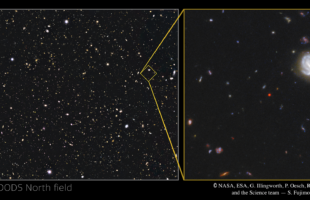Our paper is newly published from ApJ as Fujimoto et al. 2020a, ApJ, 891, 64 (ADS).
We present morphological properties in the high-resolution (FWHM ∼ 0″15) ALMA 1 mm map for an ultraluminous quasar at z = 6.30, SDSS J0100+2802, whose black hole (BH) mass MBH is the most massive (∼1.2 × 10^10Msun) at z > 6 ever known. We find that the 1-mm continuum emission of J0100+2802 is resolved into a quadruple system within a radius of 0″2, which can be interpreted as either multiple dusty star-forming regions in the host galaxy or multiple images due to strong gravitational lensing. Although a high-resolution map taken with HST shows a morphology with an apparently single component, in our fiducial lens mass model it can simply be explained by a ∼50 pc scale offset between the ALMA and HST emission regions.






